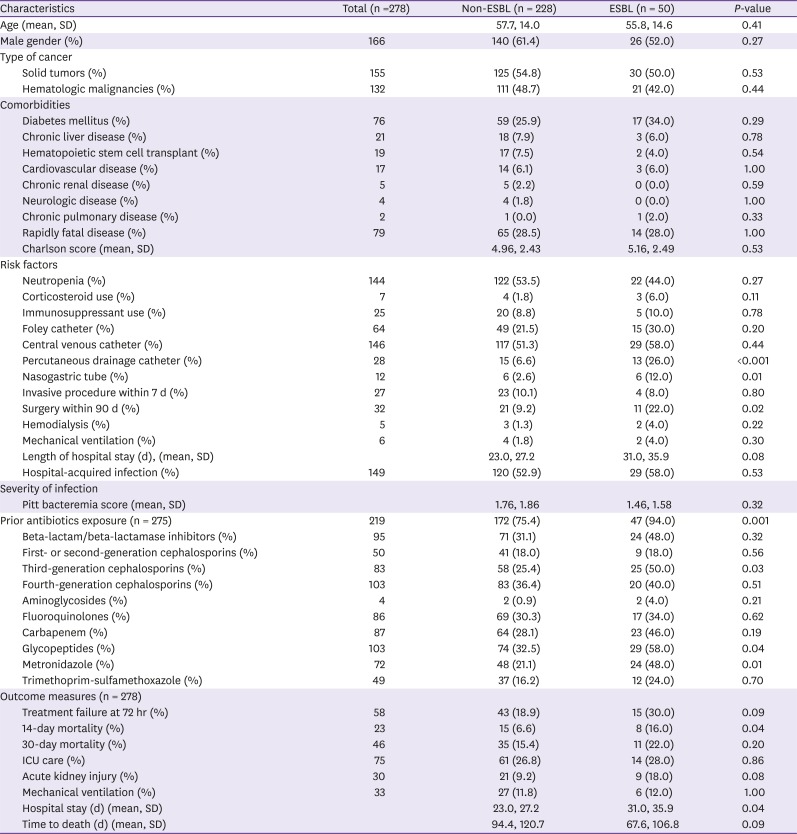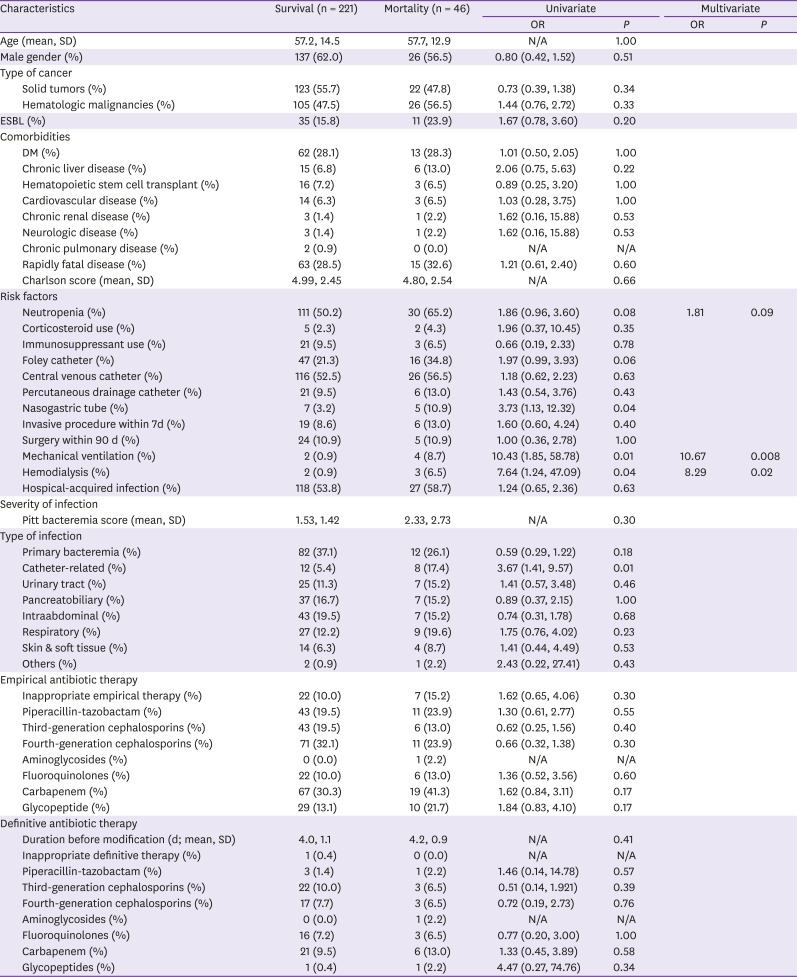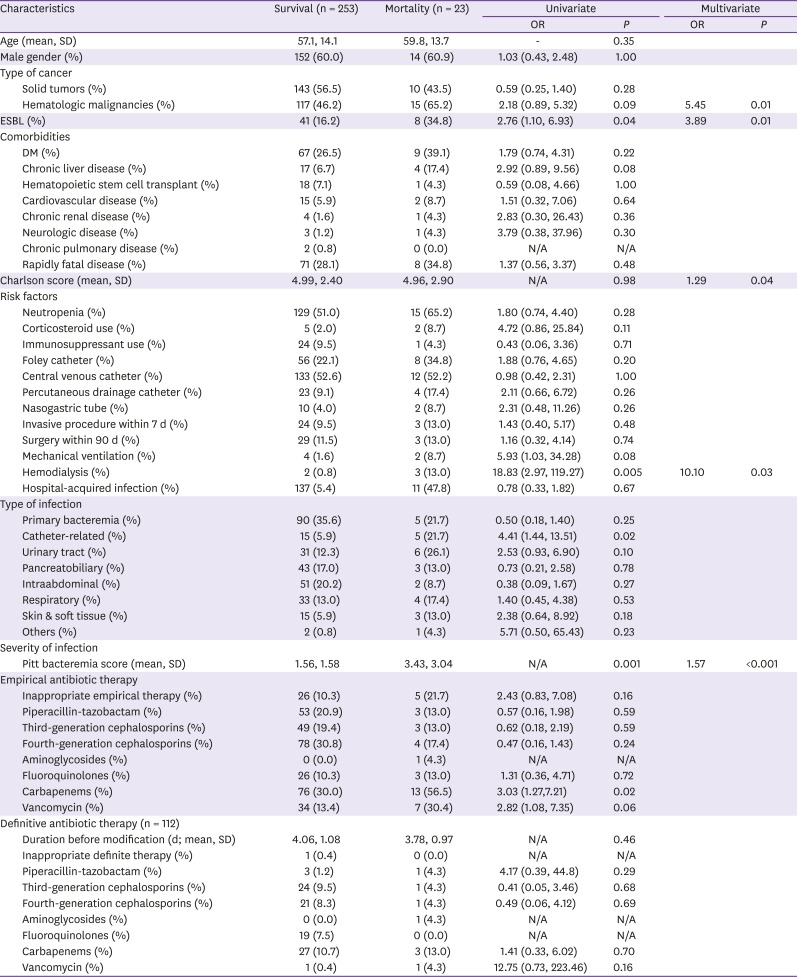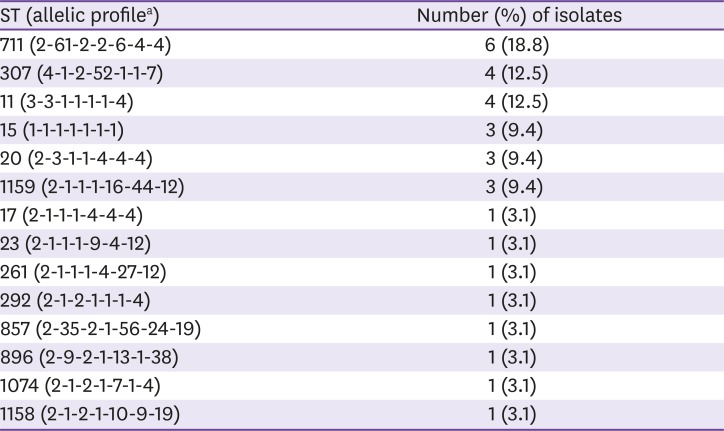1. Montassier E, Batard E, Gastinne T, Potel G, de La Cochetière MF. Recent changes in bacteremia in patients with cancer: a systematic review of epidemiology and antibiotic resistance. Eur J Clin Microbiol Infect Dis. 2013; 32:841–850. PMID:
23354675.

2. Podschun R, Ullmann U.
Klebsiella spp. as nosocomial pathogens: epidemiology, taxonomy, typing methods, and pathogenicity factors. Clin Microbiol Rev. 1998; 11:589–603. PMID:
9767057.
3. Chetcuti Zammit S, Azzopardi N, Sant J. Mortality risk score for
Klebsiella pneumoniae bacteraemia. Eur J Intern Med. 2014; 25:571–576. PMID:
24814431.
4. Paterson DL, Bonomo RA. Extended-spectrum beta-lactamases: a clinical update. Clin Microbiol Rev. 2005; 18:657–686. PMID:
16223952.
5. Schneeweiss S, Setoguchi S, Weinblatt ME, Katz JN, Avorn J, Sax PE, Levin R, Solomon DH. Anti-tumor necrosis factor alpha therapy and the risk of serious bacterial infections in elderly patients with rheumatoid arthritis. Arthritis Rheum. 2007; 56:1754–1764. PMID:
17530704.
6. Smitten AL, Choi HK, Hochberg MC, Suissa S, Simon TA, Testa MA, Chan KA. The risk of hospitalized infection in patients with rheumatoid arthritis. J Rheumatol. 2008; 35:387–393. PMID:
18260176.
7. Friedman ND, Kaye KS, Stout JE, McGarry SA, Trivette SL, Briggs JP, Lamm W, Clark C, MacFarquhar J, Walton AL, Reller LB, Sexton DJ. Health care--associated bloodstream infections in adults: a reason to change the accepted definition of community-acquired infections. Ann Intern Med. 2002; 137:791–797. PMID:
12435215.

8. Paterson DL, Ko WC, Von Gottberg A, Mohapatra S, Casellas JM, Goossens H, Mulazimoglu L, Trenholme G, Klugman KP, Bonomo RA, Rice LB, Wagener MM, McCormack JG, Yu VL. Antibiotic therapy for
Klebsiella pneumoniae bacteremia: implications of production of extended-spectrum beta-lactamases. Clin Infect Dis. 2004; 39:31–37. PMID:
15206050.
9. Charlson ME, Pompei P, Ales KL, MacKenzie CR. A new method of classifying prognostic comorbidity in longitudinal studies: development and validation. J Chronic Dis. 1987; 40:373–383. PMID:
3558716.

10. Khwaja A. KDIGO clinical practice guidelines for acute kidney injury. Nephron Clin Pract. 2012; 120:c179–84. PMID:
22890468.

11. Mermel LA, Allon M, Bouza E, Craven DE, Flynn P, O'Grady NP, Raad II, Rijnders BJ, Sherertz RJ, Warren DK. Clinical practice guidelines for the diagnosis and management of intravascular catheter-related infection: 2009 Update by the Infectious Diseases Society of America. Clin Infect Dis. 2009; 49:1–45. PMID:
19489710.

12. Lee JA, Kang CI, Joo EJ, Ha YE, Kang SJ, Park SY, Chung DR, Peck KR, Ko KS, Lee NY, Song JH. Epidemiology and clinical features of community-onset bacteremia caused by extended-spectrum beta-lactamase-producing Klebsiella pneumoniae. Microb Drug Resist. 2011; 17:267–273. PMID:
21388296.
13. Tumbarello M, Spanu T, Sanguinetti M, Citton R, Montuori E, Leone F, Fadda G, Cauda R. Bloodstream infections caused by extended-spectrum-beta-lactamase-producing
Klebsiella pneumoniae: risk factors, molecular epidemiology, and clinical outcome. Antimicrob Agents Chemother. 2006; 50:498–504. PMID:
16436702.
14. Tuon FF, Kruger M, Terreri M, Penteado-Filho SR, Gortz L.
Klebsiella ESBL bacteremia-mortality and risk factors. Braz J Infect Dis. 2011; 15:594–598. PMID:
22218521.
15. Paterson DL, Ko WC, Von Gottberg A, Mohapatra S, Casellas JM, Goossens H, Mulazimoglu L, Trenholme G, Klugman KP, Bonomo RA, Rice LB, Wagener MM, McCormack JG, Yu VL. International prospective study of
Klebsiella pneumoniae bacteremia: implications of extended-spectrum beta-lactamase production in nosocomial Infections. Ann Intern Med. 2004; 140:26–32. PMID:
14706969.
16. Mosqueda-Gómez JL, Montaño-Loza A, Rolón AL, Cervantes C, Bobadilla-del-Valle JM, Silva-Sánchez J, Garza-Ramos U, Villasís-Keever A, Galindo-Fraga A, Palacios GM, Ponce-de-León A, Sifuentes-Osornio J. Molecular epidemiology and risk factors of bloodstream infections caused by extended-spectrum beta-lactamase-producing
Klebsiella pneumoniae A case-control study. Int J Infect Dis. 2008; 12:653–659. PMID:
18511321.
17. Chopra T, Marchaim D, Johnson PC, Chalana IK, Tamam Z, Mohammed M, Alkatib S, Tansek R, Chaudhry K, Zhao JJ, Pogue JM, Kaye KS. Risk factors for bloodstream infection caused by extended-spectrum beta-lactamase-producing Escherichia coli and Klebsiella pneumoniae: A focus on antimicrobials including cefepime. Am J Infect Control. 2015; 43:719–723. PMID:
25934068.
18. Lee SO, Lee ES, Park SY, Kim SY, Seo YH, Cho YK. Reduced use of third-generation cephalosporins decreases the acquisition of extended-spectrum beta-lactamase-producing
Klebsiella pneumoniae
. Infect Control Hosp Epidemiol. 2004; 25:832–837. PMID:
15518024.
19. Superti SV, Augusti G, Zavascki AP. Risk factors for and mortality of extended-spectrum-beta-lactamase-producing
Klebsiella pneumoniae and
Escherichia coli nosocomial bloodstream infections. Rev Inst Med Trop Sao Paulo. 2009; 51:211–216. PMID:
19739001.
20. Harris AD, Karchmer TB, Carmeli Y, Samore MH. Methodological principles of case-control studies that analyzed risk factors for antibiotic resistance: a systematic review. Clin Infect Dis. 2001; 32:1055–1061. PMID:
11264034.

21. Harris AD, Samore MH, Lipsitch M, Kaye KS, Perencevich E, Carmeli Y. Control-group selection importance in studies of antimicrobial resistance: examples applied to
Pseudomonas aeruginosa, Enterococci, and
Escherichia coli
. Clin Infect Dis. 2002; 34:1558–1563. PMID:
12032889.
22. Lautenbach E, Patel JB, Bilker WB, Edelstein PH, Fishman NO. Extended-spectrum beta-lactamase-producing
Escherichia coli and
Klebsiella pneumoniae: risk factors for infection and impact of resistance on outcomes. Clin Infect Dis. 2001; 32:1162–1171. PMID:
11283805.
23. Paterson DL. Looking for risk factors for the acquisition of antibiotic resistance: a 21st-century approach. Clin Infect Dis. 2002; 34:1564–1567. PMID:
12032890.
24. Lin YT, Liu CJ, Fung CP, Tzeng CH. Nosocomial
Klebsiella pneumoniae bacteraemia in adult cancer patients--characteristics of neutropenic and non-neutropenic patients. Scand J Infect Dis. 2011; 43:603–608. PMID:
21539500.
25. Cosgrove SE. The relationship between antimicrobial resistance and patient outcomes: mortality, length of hospital stay, and health care costs. Clin Infect Dis. 2006; 42(Suppl 2):S82–S89. PMID:
16355321.

26. Johnson JR, Kuskowski MA, Gajewski A, Sahm DF, Karlowsky JA. Virulence characteristics and phylogenetic background of multidrug-resistant and antimicrobial-susceptible clinical isolates of
Escherichia coli from across the United States, 2000-2001. J Infect Dis. 2004; 190:1739–1744. PMID:
15499527.
27. Melzer M, Petersen I. Mortality following bacteraemic infection caused by extended spectrum beta-lactamase (ESBL) producing
E. coli compared to non-ESBL producing
E. coli
. J Infect. 2007; 55:254–259. PMID:
17574678.
28. Marra AR, Wey SB, Castelo A, Gales AC, Cal RG, Filho JR, Edmond MB, Pereira CA. Nosocomial bloodstream infections caused by
Klebsiella pneumoniae: impact of extended-spectrum beta-lactamase (ESBL) production on clinical outcome in a hospital with high ESBL prevalence. BMC Infect Dis. 2006; 6:24. PMID:
16478537.

29. Kim BN, Woo JH, Kim MN, Ryu J, Kim YS. Clinical implications of extended-spectrum beta-lactamase-producing
Klebsiella pneumoniae bacteraemia. J Hosp Infect. 2002; 52:99–106. PMID:
12392901.
30. Hyle EP, Lipworth AD, Zaoutis TE, Nachamkin I, Bilker WB, Lautenbach E. Impact of inadequate initial antimicrobial therapy on mortality in infections due to extended-spectrum beta-lactamase-producing enterobacteriaceae: variability by site of infection. Arch Intern Med. 2005; 165:1375–1380. PMID:
15983286.
31. Tumbarello M, Sanguinetti M, Montuori E, Trecarichi EM, Posteraro B, Fiori B, Citton R, D'Inzeo T, Fadda G, Cauda R, Spanu T. Predictors of mortality in patients with bloodstream infections caused by extended-spectrum-beta-lactamase-producing
Enterobacteriaceae: importance of inadequate initial antimicrobial treatment. Antimicrob Agents Chemother. 2007; 51:1987–1994. PMID:
17387156.









 PDF
PDF ePub
ePub Citation
Citation Print
Print



 XML Download
XML Download